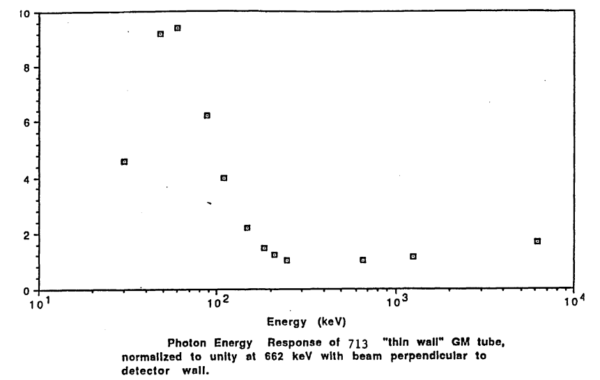| Author |
 Topic Topic  |
|
|
vaughan

South Africa
2 Posts |
 Posted - 02/22/2021 : 11:31:35 Posted - 02/22/2021 : 11:31:35


|
Hi All,
My name is Vaughan and I live in South Africa, I am interested in purchasing the GMC-500 Plus for hobby purposes.
I have examined the manual of the GMC-500 Plus and am wondering how the GMC-500 Plus would display radiation values exceeding 1.5 MeV for gamma and 3.5 MeV for beta, would it display nothing or indicate that it's max limit has been reached and passed, and what would happen if the uSv/h and mRm/h values pass their max, again, would nothing be displayed or would it indicate that it's max limit has been reached as well?
Thanks in advance
Vaughan |
|
| Reply #1
ullix
    
Germany
1203 Posts |
 Posted - 02/23/2021 : 01:28:06 Posted - 02/23/2021 : 01:28:06


|
A Geiger-Müller tube, which is the sensor in any "Geiger"-counter, does not have a specific upper limit for any type of radiation.
However, any radiation needs to enter the tube and react with either the gas or the inner surfaces, and this is where limitations arise from. Alpha can't penetrate a glass or steel wall, so it needs a super-thin window, typically made from Mica.
Betas can often reach the inside of a tube and is reacting with wall and/or gas. So Geiger-Müller tubes have the highest sensitivity for betas.
Gammas may be too energetic ("too fast") to react with anything, and thus sensitivity is low. Wikipedia has a good intro https://en.wikipedia.org/wiki/Geiger%E2%80%93M%C3%BCller_tube . Look for "energy response curve".
This next picture is from scientific work, showing the highest Gamma energy of 6MeV having a sensitivity being roughly the same down to 300keV, but then significantly increasing up to an about 10x max near 80keV. The curve will/may be different between tubes, but the basic features will remain the same.

So, gamma 1.5 MeV, like from K40 with 1.46081 MeV gamma, will be detectable albeit at the low end of sensitivities.
But while gammas almost always come as sharp peaks - the K40 line is perfect for calibrating high-resolution energy sensitive detectors - the betas always, without exception, come as a continuum with only its highest energy being the nominal energy, in your case 3.5MeV. So, betas should never be a problem.
Beta of 3.5MeV is quite a bit; which source is that?
If you are playing with Potassium, I suggest to take a look into my "Potty Training" https://sourceforge.net/projects/geigerlog/files/Articles/GeigerLog-Potty%20Training%20for%20Your%20Geiger%20Counter-v1.0.pdf/download
|
 |
|
| Reply #2
vaughan

South Africa
2 Posts |
 Posted - 02/23/2021 : 03:53:21 Posted - 02/23/2021 : 03:53:21


|
Hi Ulix,
Thanks for your response and for answering my question. Another question and please correct me if I'm wrong. Based on my deductions, any area containing radioactive material in the process of decay would produce both alpha, beta and gamma radiation and detecting either beta or gamma with the GMC-500 Plus would logically imply the existence, though not directly detected, of daughter and parent material.
It should then be possible to determine what radioactive materials are present and what other types of radiation is present, but not detectable.
Thanks in advance
Vaughan |
 |
|
| Reply #3
ullix
    
Germany
1203 Posts |
 Posted - 02/23/2021 : 05:12:35 Posted - 02/23/2021 : 05:12:35


|
No.
Easiest counter example: K-40. It decays with a billion years half life by beta (~90%) and gamma (~10%) and there is absolutely no alpha involved!
Another example: Cosmic radiation. Gamma: yes, beta: yes, also beta plus (positrons), and a whole bunch of other radioactivity-critters, but alpha would be a truly strange beast.
Seeing any counts does not imply alpha.
On the other hand, when you know there is alpha emission (but have no means to detect it) it is almost guaranteed to arise from the decay of heavy nuclei and in their decay chain you will always find beta and gamma emitters. Always. And so, yes, just to detect the presence of such radioactivity, you do NOT need a Mica windowed Geiger tube.
I am not aware of any alpha emitter, which is not, when including the full decay chain, also an emitter of beta and gamma. If there is one - I would not rule it out but I doubt it - it would probably be a strange and likely artificial one in the middle-weight spectrum of atoms, bred in any man-made installation (reactor, synchrotron, ...) which you are unlikely to ever encounter.
Detecting what that unknown radioactive substance is, is a different problem. A Geiger counter will be of little help. You need spectrographs using a NaI-crystal, or better a Ge(Li) detector (costs like a mid-size car). Perhaps even magnetic fields, cloud chambers and whatever other expensive goodies physicists like to play with ;-)
|
 |
|
| |
 Topic Topic  |
|
|
|

